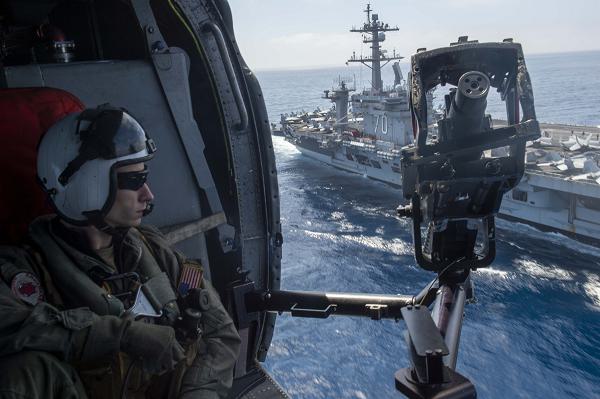
Pacific Ocean. (August 24, 2024): U.S. Navy helicopter crews are like superheroes because they swim, fly, and engage in combat while saving lives. In this photo by Seaman Kenneth Ostas, Naval Aircrewman (Helicopter) 3rd Class Michael Case, from Mountain Home, Arkansas, mans a M3 .50-caliber machine gun aboard a MH-60S Sea Hawk while underway with the Nimitz-class aircraft carrier USS Carl Vinson. Few Navy jobs offer such a range and variety of missions. An Aircrewman can expect to drop off or pick up Navy SEALs, bring supplies to ships at sea, or even jump into the water to save someone’s life. One day they are shooting at enemy planes and the next performing drastic rescues at sea.
Officially called Naval Aircrewman (Helicopter) or AWS for short, these highly skilled professionals perform search and rescue, search for mines from the air, and they insert and extract Special Operations Forces doing dangerous missions. They also fight as aerial gunners, operate radars and sonars, and conduct reconnaissance missions for the fleet. An AWS is an enlisted Sailor who doubles as loadmasters, repair technicians, and is responsible for the safe flight of their assigned aircraft.
Obviously, not everyone can qualify for such a demanding role.
To become an AWS, candidates must pass Basic training and then their thirteen-week A-School at Pensacola, Florida. Next, it is off to Naval Aircrew Candidate School for an additional six weeks of training in water and land survival as well as flight safety. The training is physically tough with topics such as aircrew tasks and assignments, survival, first aid, and water rescue procedures. Candidates must pass a class II swim test, an aviation flight physical, and the Navy Physical Fitness Assessment (PFA) prior to reporting for this demanding aircrew training.
If they survive all this, an AWS then attends the seven-week Naval Aircrew Rescue Swimmer course to develop their swimming skills followed by the grueling two-week Survival, Evasion, Resistance, Escape (SERE) course at San Diego, California.
To be eligible to enlist as an AWS, candidates must possess a High School Diploma (or equivalent), have a clean criminal and financial record, and be able to obtain the proper security clearances. Once they complete their training, an AWS may be assigned to naval air stations, squadrons, aircraft carriers, or other aviation facilities in the United States or abroad and can expect to spend around half of their time at sea.


